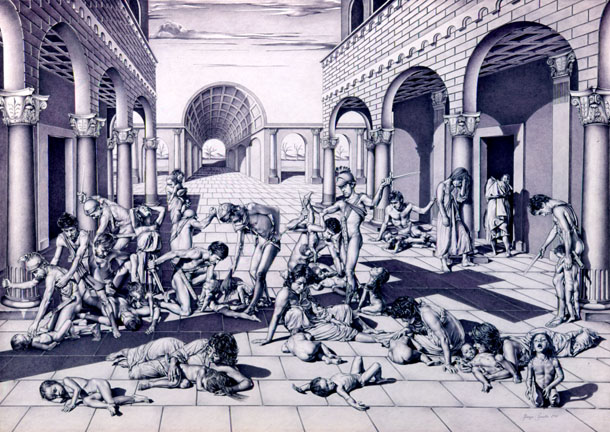The artist Giuseppe Borrello has developed his research for classical art through a particular skill for a “punta di penna”(“top of the tip”) technique which is not figuratively speaking in this case.
If we look at his way of painting we can better understand his inclination and taste for the human figure. He traces in fact the beauty of a woman’s face (Fig.1) and the fragility of childhood with great accuracy through endless patience as the ancient miniaturists did.
Borrello has made a brave choice in the current artistic situation and he shows us the correct and difficult decision he ardently pursued to achieve a powerful visual result. He evidently learned the XX Century lesson that is to say that magic moment when people reacted against the fracturing avant-garde and recovered the figurative and flexible values of our predecessors.
Borrello made this lesson his own and he has recovered the satisfying correspondence with a difficult art one can only reach through study and refinement of one’s artistic natural talent, which is so rare today.
Borrello chose to live in his own atelier and to believe in a few but sure visual elements. His inner truth leads him to look for beauty in a secret glance, in the controlled quiver of an expression in the natural movement of a strand of hair (Fig.2).
The recognizability of the real world is for Borrello unavaible compositive element in order to express his own world vision and to state the harmony and stability of shapes and volumes.
You cannot but be astonished by Borrello’s skilful use of ballpoints and metal points; with these tools the artist cannot have second thoughts,his art must be the final result of a careful contemplation of the subject and of a well thought planning. Borrello’s art is far from the tricks of appearance or illusion and even the surrounding space of his images are real. He carefully traces and achieves a sort of crystallization of the form which becomes almost sanitised. Moreover when he introduces some figures in his composition he gives them particular psychological value. Here the lack of emphasis defines precise elements and well motivated situations.
Borrello’s portraits are analytic contructions where quivering existential emotion is under control.
It is not incongruous to quote Annigoni as a point of reference even if Borrello has his own scenographic taste when he makes a difficult and complex work such as “The Slaughter of the Innocents”(Fig.3). This is an allegorical transposition in Renaissance style made with monochrome ballpoint where prospective flights, focalized by a black cross shaped shadow on a sort of metaphysical area, follows classical laws.
The statuesque presence of warriors recalls a cold bloodless violence. Children are dramatic and twisted just like the postures of desperate and defenceless women.
The compositive qualities of thi work don’t contradict the peaceful beauty of the portraits quoted above and pose further questions on inner motivations of the master of this technique.
Vittorio Sgarbi
|
Fig.1."La Greca" 1992 penna biro monocroma
cm 18,2 x 25,4
Fig.2. "Carmelina"
2001-Penna biro policrima
cm 25 x 33
Fig.3.La strage degli innocenti 1990 - penna biro monocroma - cm 102 x 73


